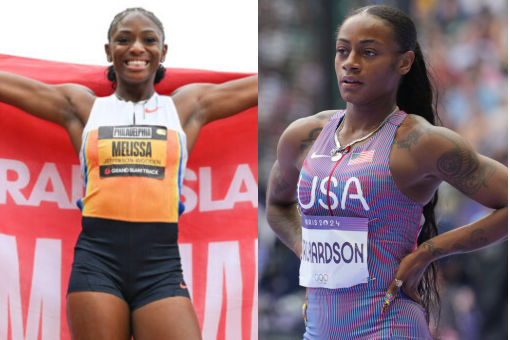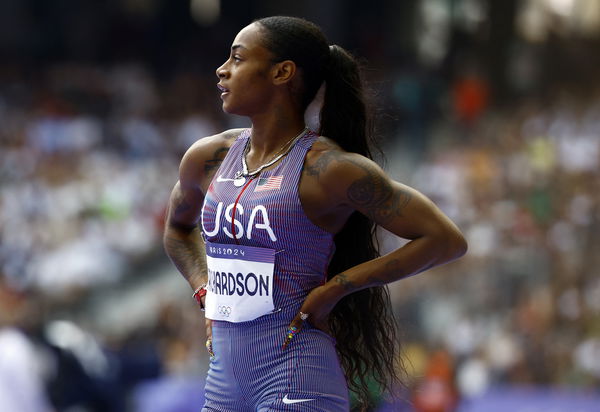
Imago
Melissa Jefferson-and Sha’Carri Richardson / Image Credits: Imago

Imago
Melissa Jefferson-and Sha’Carri Richardson / Image Credits: Imago
Justin Gatlin has rarely been one to hand out casual compliments, yet his assessment of Melissa Jefferson-Wooden left little room for debate. “She ran that race exactly the way you’re supposed to,” Gatlin remarked, describing Jefferson-Wooden’s flawless curve running and her “unclosable gap” over Gabby Thomas earlier this season. The retired Olympic champion credited her “aggressive strategy” and “superior execution,” qualities he identified as the very markers of dominance. His words carried an edge when contrasted with his cautionary note on Sha’Carri Richardson after her Paris run, “When you line up next to someone you know is a threat, you start second-guessing… But in an Olympic final, you don’t have time to think—it’s all instinctive. You’ve got to go out there like a savage. Just go!” And this season proves why the US track legend might just be on point.
Watch What’s Trending Now!
The split between Jefferson-Wooden’s surging season and Richardson’s uneven one was on display at the Brussels Diamond League on August 22. In a field featuring Jefferson-Wooden and Shelly-Ann Fraser-Pryce, Richardson found relief in claiming second. Drawn in lane six, she held her composure to clock 11.08, her first podium since Zurich last year. The American exchanged smiles with Jefferson-Wooden, greeted Fraser-Pryce with a handshake, and pointed skyward in visible relief. For Richardson, who has endured an injury setback in February, a withdrawal at the U.S. Championships, and a turbulent summer marred by off-track controversy, the moment carried significance. Yet, the performance also underscored the broader question. In 2025, her name has not entered in the ledger of the year’s fastest women.
The current list of 2025’s top ten 100-meter times is dominated by Jefferson-Wooden and rounded out by Julien Alfred and the Clayton twins. Jefferson-Wooden alone has produced five of the top six marks, including the year’s best at 10.65, achieved in Eugene with a legal wind of +0.4 m/s. Alfred has delivered a 10.75 in Stockholm and two more sub-10.80 performances, while Tina and Tia Clayton sit in the 10.81 and 10.82 range. Richardson, by contrast, has peaked at 11.05 in Silesia and 11.08 in Brussels, well clear of the leading tier.
ADVERTISEMENT
Women’s 100m fastest times in 2025
🇺🇸 Melissa Jefferson-Wooden – 10.65
🇺🇸 Melissa Jefferson-Wooden – 10.66
🇺🇸 Melissa Jefferson-Wooden – 10.73
🇱🇨 Julien Alfred – 10.75
🇺🇸 Melissa Jefferson-Wooden – 10.75
🇺🇸 Melissa Jefferson-Wooden – 10.76
🇱🇨 Julien Alfred – 10.77
🇱🇨 Julien…— Track & Field Gazette (@TrackGazette) August 23, 2025
The gap in consistency is compounded by the 200 meters.
Sha’Carri Richardson, a bronze medalist in Budapest two years ago, failed to advance past the semifinals at this year’s U.S. Championships. Her 22.56 fell a single hundredth short of qualifying, a reminder of both how thin the margins can be and how fragile her form has remained. That exit closed the door on an event once seen as a potential avenue for American depth. For Tokyo, Richardson enters only as the defending world champion in the 100, with her automatic bye sparing her from the qualification gauntlet.
ADVERTISEMENT
Jefferson-Wooden, on the other hand, has been untouchable. Her undefeated 100-meter streak now stretches to nine races, with an average margin of victory of nearly two-tenths of a second. At the U.S. Championships, she not only secured the 100 title but also the 200, becoming the first woman since 2003 to win both and posting a personal best of 21.84. In Brussels, she controlled the race in 10.76, once again setting the standard.
Others have found moments of strength, if not supremacy. Fraser-Pryce, still formidable at 38, clocked 11.17 for fourth in Brussels. Alfred continues to press into elite company, while the Claytons suggest Jamaica’s next wave is not far behind. But none have matched Jefferson-Wooden’s authority.
ADVERTISEMENT
As the World Championships approach, the narrative is unmistakable. Jefferson-Wooden carries America’s gold medal hopes with performances that mirror the precision Gatlin once demanded of himself. Richardson, meanwhile, remains outside the year’s fastest ranks, stepping into Tokyo with a reputation intact but form still chasing the clock. Sha’Carri Richardson’s reign as world champion now hinges on whether she can overcome her persistent struggles with reaction time and mid-race rhythm.
Sha’Carri Richardson’s slow starts put her world title defense in jeopardy
Sha’Carri Richardson’s title as world champion rests on fragile ground if her start continues to betray her. In a discipline where fractions separate gold from defeat, her reaction times have become the persistent flaw in an otherwise formidable profile.
ADVERTISEMENT
At the Paris Games, her slowest-in-the-field reaction time of 0.221 seconds left her chasing, not leading, and recent performances suggest that the same hesitation remains. At the Seiko Golden Grand Prix, her reaction was again the slowest among all finalists, 0.181 seconds, confirming that this weakness is not incidental. The concern is no longer about potential but about repetition, as athletes like Julien Alfred have demonstrated consistently sharper exits from the blocks.

Reuters
Paris 2024 Olympics – Athletics – Women’s 100m Round 1 – Stade de France, Saint-Denis, France – August 02, 2024. Sha’Carri Richardson of United States looks on after winning heat 1. REUTERS/Sarah Meyssonnier
The problem is compounded by her inability to recover lost ground in the mid-phase of the race. Richardson’s strength has long been her ability to generate momentum after thirty meters, using her stride length to extend separation once upright. That dynamic was clear at the 2023 World Championships, where she shifted into a series of 0.90-second splits en route to victory. This year, however, her 11.47 seconds in Tokyo and 11.19 in Eugene suggest the rhythm is missing. Even her own words after Prefontaine, “I prayed for a healthy race, and I got a healthy race. When I am 100 percent, there’s nothing that can really stop me but me,” now echo with uneasy weight, for the evidence indicates the problem lies directly in her mechanics and execution.
ADVERTISEMENT
Equally pressing is her limited race schedule.
Top Stories
Forced to Leave FOX, Cowboys Legend Troy Aikman Says ESPN Is Like ‘U.S. Government’ & Clearly Distinguishes the Two Networks

Who Is Paige Shiver? All About Michigan Football Staffer & Daughter of Veteran Bears Scout Jeff Shiver

FOX Issues Strict Ban on Terry Bradshaw But NFL Legend Defies It to Join Popular Morning Show

Michael Jordan Brings NASCAR to Its Knees as Jim France’s Courtroom Collapse Triggers Settlement

What Happened to T.J. Watt? Why Is He Hospitalized? Steelers Announce Latest News on LB Before Dolphins Game

LIV Golf to Cut Ties With Veteran Pro After His PGA Tour Return Intentions Became Public

While others sharpen through competition, Richardson has entered only two 100-meter contests in 2025. The absence of repetition is evident in her lack of fluency throughout the phases of the sprint.
So, the reigning champion cannot depend solely on September readiness without addressing the starting block hesitation and the fading mid-race intensity. If those remain uncorrected, the title she once seized so forcefully may slip from her grasp in the very opening strides.
ADVERTISEMENT
What are your speculations, though? Share with us in the comments…
ADVERTISEMENT
ADVERTISEMENT
ADVERTISEMENT

